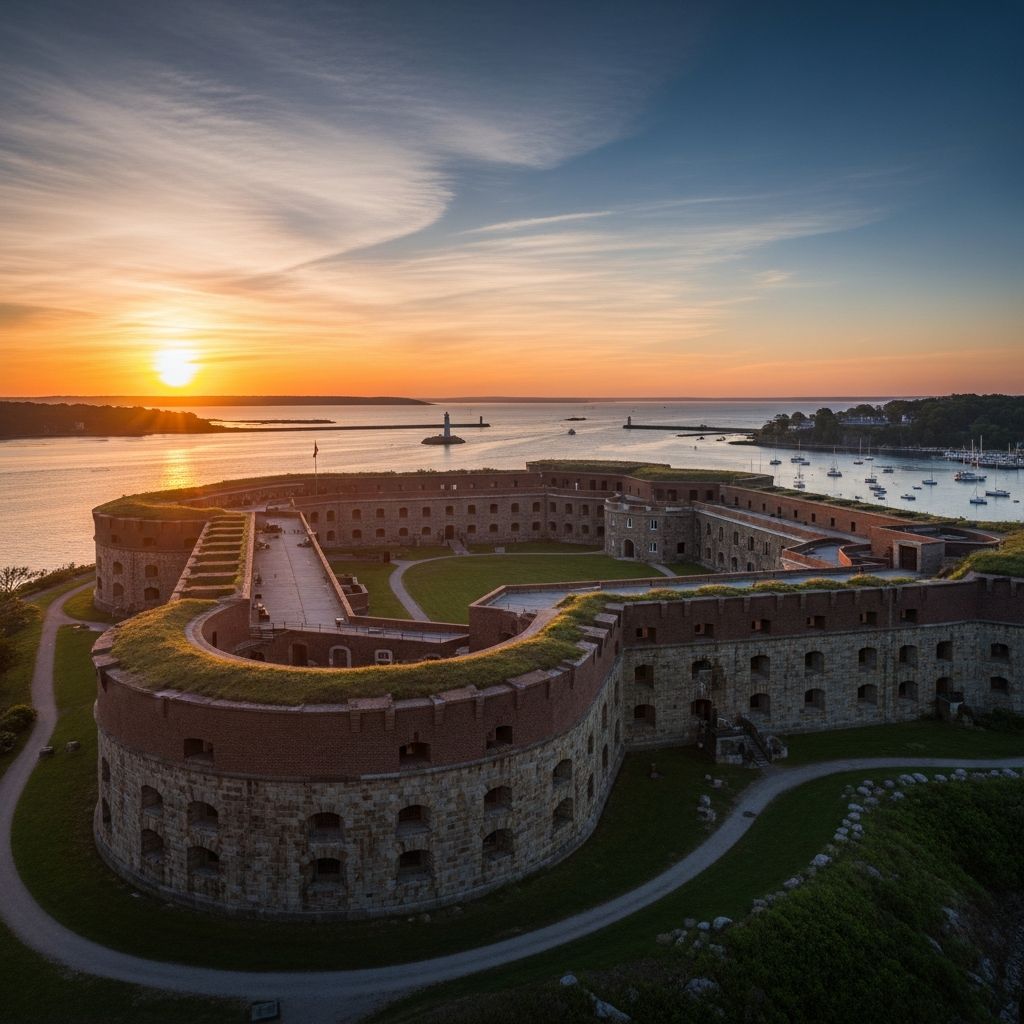Fort Adams: Guardian of Newport’s Harbor and American History
Explore the monumental legacy of Fort Adams: Newport’s fortress of architecture, military strategy, and cultural transformation.

Fort Adams, towering above Newport Harbor on Aquidneck Island, is more than an imposing coastal fortification—it is a testament to three centuries of American military ingenuity, international influence, and local legacy. From its colonial beginnings, through the turbulence of multiple wars, to its contemporary role as a vibrant state park and landmark, Fort Adams stands as a living chronicle of Rhode Island’s—and America’s—strategic evolution.
Overview and Significance
- Constructed: 1824–1857 (current fort), with earlier fortifications dating to the 18th century .
- Name: Honors President John Adams, second President of the United States .
- Location: Entrance to Newport Harbor, guarding Narragansett Bay .
- Status: National Historic Landmark, State Park, and cultural destination .
Table: Key Features of Fort Adams
| Attribute | Details |
|---|---|
| Geometry | Pentagonal layout, inspired by European military architecture |
| Size | Main perimeter: 1,749 yards; covers 20 acres |
| Armament | Originally designed to mount up to 468–500 guns |
| Materials | Granite, brick, shale, and earthworks |
| Capacity | 2,400 soldiers during wartime ; peace-time garrison ~200 |
Historical Development
Colonial and Revolutionary Beginnings
The site’s defensive legacy dates to the 1690s when Newport’s booming commerce demanded protection from pirates and European navies. Early colonial forts, notably on Brenton Point, sought to shelter Newport’s food-supply trade, privateering, and the region’s role in the Atlantic triangular trade .
- 1740: Observation post established—marking the earliest military use of the future Fort Adams site.
- French and Indian War: Earthwork fortifications erected .
Revolutionary War Era
In spring 1776, rapid fortifications went up as hostilities erupted. But by December, British forces occupied Newport, destroying the initial installations and leaving the town under enemy control until 1779 .
Birth of Fort Adams (1799–1824)
- 1799: Battery of cannons established, named for President John Adams .
- Early Features: Simple masonry enclosure with 12–17 guns, brick magazine, and wooden soldiers’ quarters .
- Commander: Captain John Henry, later influential in the lead-up to the War of 1812 .
The War of 1812 highlighted Newport’s vulnerability and the inadequacy of contemporary coastal defenses, prompting a new era of fortification .
The “Third System” and Strategic Expansion (1824–1857)
After the War of 1812 exposed national defense weaknesses—especially after the burning of Washington, D.C.—a coordinated effort was launched. The “Third System” aimed to construct advanced coastal fortifications nationwide .
- Designers: Simon Bernard (French engineer, ex-Napoleonic aide) and Joseph G. Totten (future head of Army Corps of Engineers) .
- Influence: European, especially French, military science; fort designed as an irregular pentagon for optimized defense .
- Construction: Spanned three decades, involving Irish laborers and Scottish stonemason Alexander McGregor .
- Purpose: Defend against both land and sea attacks; accommodate new military technologies and tactics .
Fort Adams emerged as the largest, most complex coastal defense work of its kind in the U.S., rivaling only Fort Monroe (VA) and Fort Jefferson (FL) in scale .
Architectural and Military Details
Distinctive Features
- Pentagonal Shape: Modeled on European defenses for multilayered protection and crossfire .
- Material Mastery: Combination of Maine granite, brick vaulting, and shale. Extensive use of earthy ramparts and ditches .
- Outer Works: Extensive landward bastions and a separate granite redoubt beyond the main walls .
- Subterranean Galleries: Tunnels and galleries for troops and munitions .
- Artillery Mounts: Designed originally for 468–500 guns, including both coastal and land-facing batteries .
Military Operations Through the Ages
- War of 1812: Garrisoned, but under-defended; exposed broader coastal vulnerabilities .
- Civil War: Fort Adams served as a staging ground; briefly hosted the relocated U.S. Naval Academy .
- World War I: Training center; deployment of troops overseas; harbor protected by mines and anti-submarine nets .
- World War II: Rapid construction of new structures, anti-aircraft batteries, controlled minefields; served as command post for Harbor Defenses of Narragansett Bay .
- Postwar Period: Used by the Eisenhower administration as a summer White House .
Historic Recognition and Preservation
- State Acquisition: In 1964, the site (80 acres) was deeded to Rhode Island and became Fort Adams State Park .
- Landmark Status: Listed in the National Register of Historic Places (1970) and designated a National Historic Landmark (1976) .
- Ongoing Preservation: The Fort Adams Trust, founded in 1994, administers the fort’s historic interpretation and preservation .
Fort Adams Today
Park, Recreation, and Public Engagement
- Interpretive Programs: Guided historical tours reveal the fort’s strategic engineering and storied past .
- Event Venue: Hosts major cultural events, including the world-famous Newport Jazz and Folk Festivals; community gatherings, and weddings .
- Recreational Amenities: Soccer fields, marina, walking trails, picnic facilities, and public waterfront access .
- Modern Additions: The Sail Newport Barn (1999) supports sailing programs .
Fort Adams remains a vibrant destination, balancing its roles as a historical monument and a hub for contemporary recreation and culture.
Accessibility and Visitor Experience
- Location: Easily accessed within Newport, close to Brenton Point State Park and other coastal attractions .
- Authentic Experience: Visitors can explore battlements, tunnels, and parade grounds, guided by experts—or independently .
- Parking and Services: Ample parking, visitor information, restrooms, and picnic areas available .
Frequently Asked Questions (FAQs)
Q1: Why is Fort Adams designed as a pentagon?
Fort Adams features a pentagonal design modeled after European military architecture, specifically principles pioneered by Sebastien Le Prestre de Vauban and adapted by Simon Bernard. This shape enables layered defenses and interlocking fields of fire against both land and sea attacks .
Q2: Did Fort Adams ever engage in active battle?
The fort never came under direct attack or siege in wartime. Despite its strategic importance, Newport avoided major armed conflict after the Revolution, and the fort instead served as a key training, staging, and command center through subsequent wars .
Q3: What are the most distinctive architectural features?
- Pentagonal granite and brick walls with extensive earthworks.
- Outer and inner ditches, tunnels, and vaulted magazines.
- Separate redoubt and outworks for layered protection.
Q4: How can visitors experience Fort Adams today?
Visitors can choose guided tours highlighting the unique engineering and military story, self-guided exploration of multiple fort sections, or participate in festivals and community events. The park also features recreational amenities including fields, water sports, and walking trails .
Q5: Is Fort Adams a National Historic Landmark?
Yes. Fort Adams was listed on the National Register of Historic Places in 1970 and designated as a National Historic Landmark in 1976, reflecting its scale, preservation, and historic significance within U.S. military history .
Legacy: Fort Adams and Newport’s Identity
Fort Adams stands astride a crucial intersection of military innovation, cultural transformation, and local heritage. Its construction demanded immense labor and vision, integrating French engineering with American adaptation. For Newport, the fort signaled a shift from colonial mercantile power to national strategic relevance.
- Community Impact: The Irish laborers who built the fort established Newport’s Fifth Ward and contributed to the city’s cultural mosaic .
- Historic Firsts: The nearby Catholic church, built by those laborers, later hosted the wedding of Senator John F. Kennedy and Jacqueline Bouvier .
- Symbolic Power: Fort Adams remains a visible emblem of American determination to defend its shores and adapt to changing times.
Nearby Attractions
- Brenton Point State Park: Located nearby, offers scenic ocean views, hiking, and picnicking.
- Newport Historic District: Home to colonial landmarks, museums, and vibrant shopping and dining.
- Mansions of Newport: Grand Gilded Age estates such as The Breakers and Marble House.
- Water Activities: Narragansett Bay is renowned for sailing, kayaking, and waterfront tours.
Planning Your Visit to Fort Adams
- Best Seasons: Spring through fall for tours and outdoor recreation; special festivals offered in summer months.
- Guided Tours: Recommended for those seeking deep insight into military history and architecture.
- Accessibility: The grounds feature wheelchair accommodations and child-friendly programs.
- Events Calendar: Check local listings for concerts, festivals, and educational workshops.
Fort Adams: Quick Facts & FAQ
- Where: Newport, Rhode Island—entrance to Newport Harbor and Narragansett Bay
- Who Built It: Chief engineers Simon Bernard and Joseph G. Totten, constructed mainly by Irish and Scottish craftsmen
- Historic Use: U.S. Army post, U.S. Naval Academy site, World Wars command center, Eisenhower summer White House
- Current Use: Rhode Island State Park, public recreation, event venue
References and Further Reading
- Rhode Island State Parks – Fort Adams History
- Legends of America: Fort Adams
- The Cultural Landscape Foundation: Fort Adams
- Providence Journal: Fort Adams European Design
- Newport Discovery Guide: Fort Adams
- American Battlefield Trust: Fort Adams
- Historic Preservation & Heritage Commission, Rhode Island
- ArtInRuins: Fort Adams State Park












